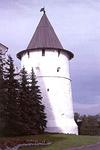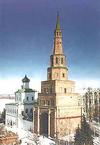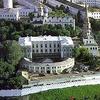| The Fortification Complex |
 The historical citadel of the Kazan Kremlin is an archaeological monument that is unrivalled. The underlying strata, beginning at the threshold of the 10th and 11th centuries, range from 2 to 8 metres in thickness. In the oldest, northern part of the citadel, remains of stone and wooden public housing and utility buildings have been discovered, as well as everyday and religious artifacts belonging to the culture of the Golden Horde and the Kazan Khanate epochs. The historical citadel of the Kazan Kremlin is an archaeological monument that is unrivalled. The underlying strata, beginning at the threshold of the 10th and 11th centuries, range from 2 to 8 metres in thickness. In the oldest, northern part of the citadel, remains of stone and wooden public housing and utility buildings have been discovered, as well as everyday and religious artifacts belonging to the culture of the Golden Horde and the Kazan Khanate epochs.
|
|
| The Suyumbike Tower |
 The Suyumbike Tower in the complex of the Governor's Palace is the historical pearl and the architectural symbol of Kazan. Its name is linked to the last queen of the Kazan Khanate Suyumbike, the wife of the two last khans of Kazan. It is 58 metres high, has seven tiers and is built of red brick. The three lower tetrahedrons go up in steps and are bordered by open terraces. The first tier has an archway, therefore the tower served as the passageway to the inner court of the commandant's house, which came to supplant the old 'khan's court'. The Suyumbike Tower in the complex of the Governor's Palace is the historical pearl and the architectural symbol of Kazan. Its name is linked to the last queen of the Kazan Khanate Suyumbike, the wife of the two last khans of Kazan. It is 58 metres high, has seven tiers and is built of red brick. The three lower tetrahedrons go up in steps and are bordered by open terraces. The first tier has an archway, therefore the tower served as the passageway to the inner court of the commandant's house, which came to supplant the old 'khan's court'.
|
|
| The Khan`s Courtyard and the complex of the Governor`s Palace |
 A street leads straight as an arrow from the Spasskaya Tower archway into the oldest and highest part of the Kazan Kremlin. It is here, on the ground of the former palace complex of the khans of Kazan, that the Govenor's palace has been situated since the middle of the 19th century. Today it serves as the official residence of the President of the Republic of Tatarstan. A street leads straight as an arrow from the Spasskaya Tower archway into the oldest and highest part of the Kazan Kremlin. It is here, on the ground of the former palace complex of the khans of Kazan, that the Govenor's palace has been situated since the middle of the 19th century. Today it serves as the official residence of the President of the Republic of Tatarstan.
|
|
| The complex of the Cathedral of the Annunciation |
 Close to the complex of the Governor's Palace lies the complex of the Cathedral of the Annunciation. The cathedral is the largest building in the Kazan Kremlin and the oldest of the preserved stone constructions in Kazan. It was built in 1561-1562 by the Pskov architects Postnik Yakovlev and Ivan Shiryai in the north-eastern part of the Kremlin: their architectural heritage makes the Kazan Kremlin the most south-eastern point of the spread of the Pskov-Novgorod style monuments in Russia. Close to the complex of the Governor's Palace lies the complex of the Cathedral of the Annunciation. The cathedral is the largest building in the Kazan Kremlin and the oldest of the preserved stone constructions in Kazan. It was built in 1561-1562 by the Pskov architects Postnik Yakovlev and Ivan Shiryai in the north-eastern part of the Kremlin: their architectural heritage makes the Kazan Kremlin the most south-eastern point of the spread of the Pskov-Novgorod style monuments in Russia.
|
|
| The Kazan State University |
 Kazan State University was established in 1804 and for a lot of years remained Russia's easternmost higher education establishment. Kazan University scholars have made a great contribution in the development of natural sciences as well as humanities. The names of the outstanding Tatar scholars of the past who represented its schools of geography and ethnography include Kh.Fayezkhanov, I.Khalfin and K.Nasyri. Kazan State University was established in 1804 and for a lot of years remained Russia's easternmost higher education establishment. Kazan University scholars have made a great contribution in the development of natural sciences as well as humanities. The names of the outstanding Tatar scholars of the past who represented its schools of geography and ethnography include Kh.Fayezkhanov, I.Khalfin and K.Nasyri.
|
|
| The Kazan Kremlin |
 A unique complex (13 ha) of archaeological, historical and architectural monuments that emerged and have been functioning since its foundation in the 12th century and to the present day. It incorporates the archaeological relics of the first (the 12th -13th centuries), the second (the 14th -15th centuries) and the third (the 15th -16th centuries) Kazan sites, stone-and-brick Kremlin (the 16th -18th centuries) and a number of buildings and structures of the 16th -19th centuries of high historical and cultural significance, which associated with various historic events in the city life. A unique complex (13 ha) of archaeological, historical and architectural monuments that emerged and have been functioning since its foundation in the 12th century and to the present day. It incorporates the archaeological relics of the first (the 12th -13th centuries), the second (the 14th -15th centuries) and the third (the 15th -16th centuries) Kazan sites, stone-and-brick Kremlin (the 16th -18th centuries) and a number of buildings and structures of the 16th -19th centuries of high historical and cultural significance, which associated with various historic events in the city life.
|
|


